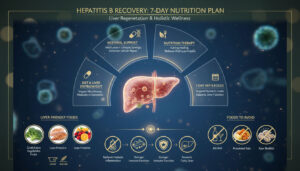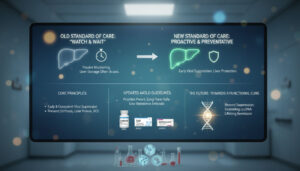For decades, the image of a steaming bowl of oatmeal has been synonymous with health. It is the breakfast of choice for heart patients, the go-to recommendation from general practitioners, and the comfort food we turn to on cold mornings. We are told it lowers cholesterol. We are told it provides sustained energy. Yet, for millions of Americans navigating the complex waters of metabolic health, this advice often leads to a frustrating paradox. You diligently eat your morning oats, believing you are making the virtuous choice, yet your blood sugar readings remain stubbornly high, your midsection refuses to shrink, and your liver enzymes fail to improve.
This confusion is not your fault. The problem lies in a critical nuance that is often lost in generic dietary guidelines. We tend to view “oats” as a single, uniform category of food. In reality, the distance between a steel-cut oat groat and a packet of instant oatmeal is vast. They may share the same botanical name, Avena sativa, but once they hit your digestive system, they act like two entirely different substances.

Does instant oatmeal spike blood sugar?
Yes. Because instant oatmeal is highly processed, pressed remarkably thin, and pre-cooked during manufacturing, it digests with alarming speed. This results in a high Glycemic Index (GI) of up to 83. When consumed, it causes a sharp, rapid rise in blood glucose and insulin that rivals the biological response to eating a dessert. For those managing insulin resistance or MASLD (fatty liver disease), this rapid surge is not just a momentary energy boost; it is a metabolic signal that promotes fat storage in the liver and complicates disease management.
The danger lies in the processing. When we strip an oat of its structural integrity and transform it into instant mush, we fundamentally alter how our biology interacts with it. This comprehensive guide explores why oatmeal fatty liver issues arise from selecting the wrong type of oats and provides a roadmap for switching to steel cut oats vs rolled oats to reclaim your metabolic health.
Why Not All Oats Are Created Equal
To truly understand why your “healthy” breakfast might be silently hurting your liver, we have to look at physics before we look at nutrition labels. The primary driver of an instant oatmeal blood sugar spike is not just the carbohydrate content itself, but the surface area of the particles you are swallowing.
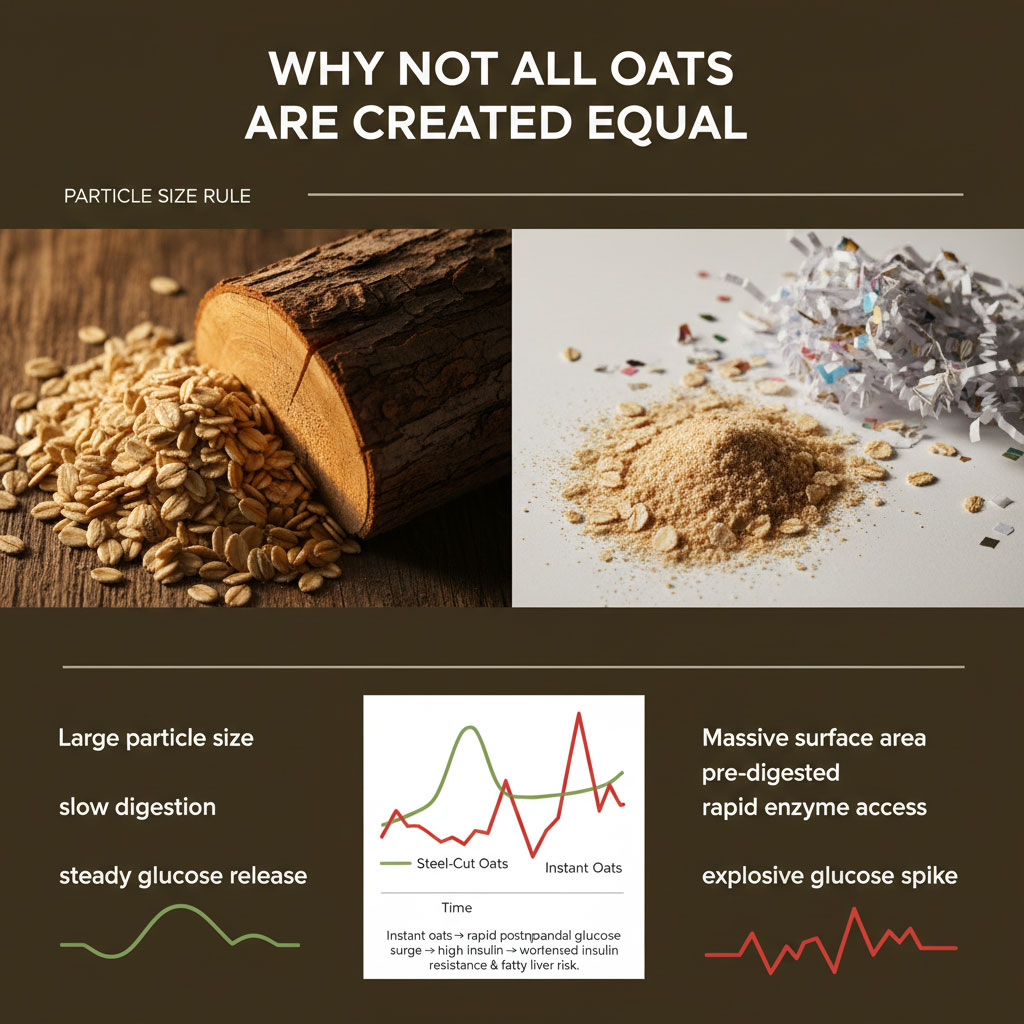
The Particle Size Rule
Digestion is, at its core, a race. It is a competition between your stomach enzymes and the structural integrity of the food you eat. When you consume whole foods, such as intact grains, vegetables, or proteins, your body must exert significant mechanical and chemical effort to break them down. Your teeth must chew, your stomach must churn, and your enzymes must peel away layers of fiber to access the energy inside. This effort is beneficial. It slows the release of sugar into your bloodstream, creating a gentle, manageable trickle of energy.
Instant oats defy this rule. During manufacturing, they are steamed, rolled flat, and often pulverized into tiny fragments to ensure they cook instantly when hot water is added. This process essentially pre-digests the food for you. By the time it reaches your bowl, the hard work has already been done by a machine. This massive increase in surface area means that your digestive enzymes can attack the starch molecules all at once. The result is not a slow release of energy; it is an explosion.
Defining the Spike
Think of your metabolism like a fireplace. If you place a solid, dense log onto the fire, it will catch slowly. It burns steadily, providing consistent warmth for hours without overwhelming the hearth. This is how steel cut oats behave in your body. They are the log.
Instant oatmeal, on the other hand, is akin to throwing a handful of shredded paper or confetti into the flames. It flares up instantly, creating a massive burst of heat that can be dangerous if not contained, and then it burns out just as quickly. This flare-up is what endocrinologists refer to as a high postprandial glucose response.
When this confetti-like flare-up occurs in your body, your blood sugar skyrockets within minutes of eating. Your pancreas detects this emergency and responds by flooding your system with insulin to bring those dangerous levels down. For a metabolically flexible athlete, this might be manageable. For someone dealing with insulin resistance or fatty liver disease, this is a metabolic disaster. The insulin spike locks the body into fat-storage mode, preventing you from burning your own body fat for fuel.
The Liver Connection: From Sugar to Fat
The link between oatmeal fatty liver risks and high-glycemic foods is driven by a sophisticated biological process known as De Novo Lipogenesis. While we often associate liver damage with alcohol, the modern epidemic of MASLD is largely driven by how our livers handle rapid influxes of energy.
De Novo Lipogenesis and Hepatosteatosis
Your liver is the chemical factory of your body. One of its jobs is to manage energy distribution. When you consume a bowl of flavored instant oats, the glucose hits your liver faster than it can be utilized for immediate energy. Your liver has a limited storage capacity for glucose, which it stores as glycogen. Think of glycogen as a small fuel tank.
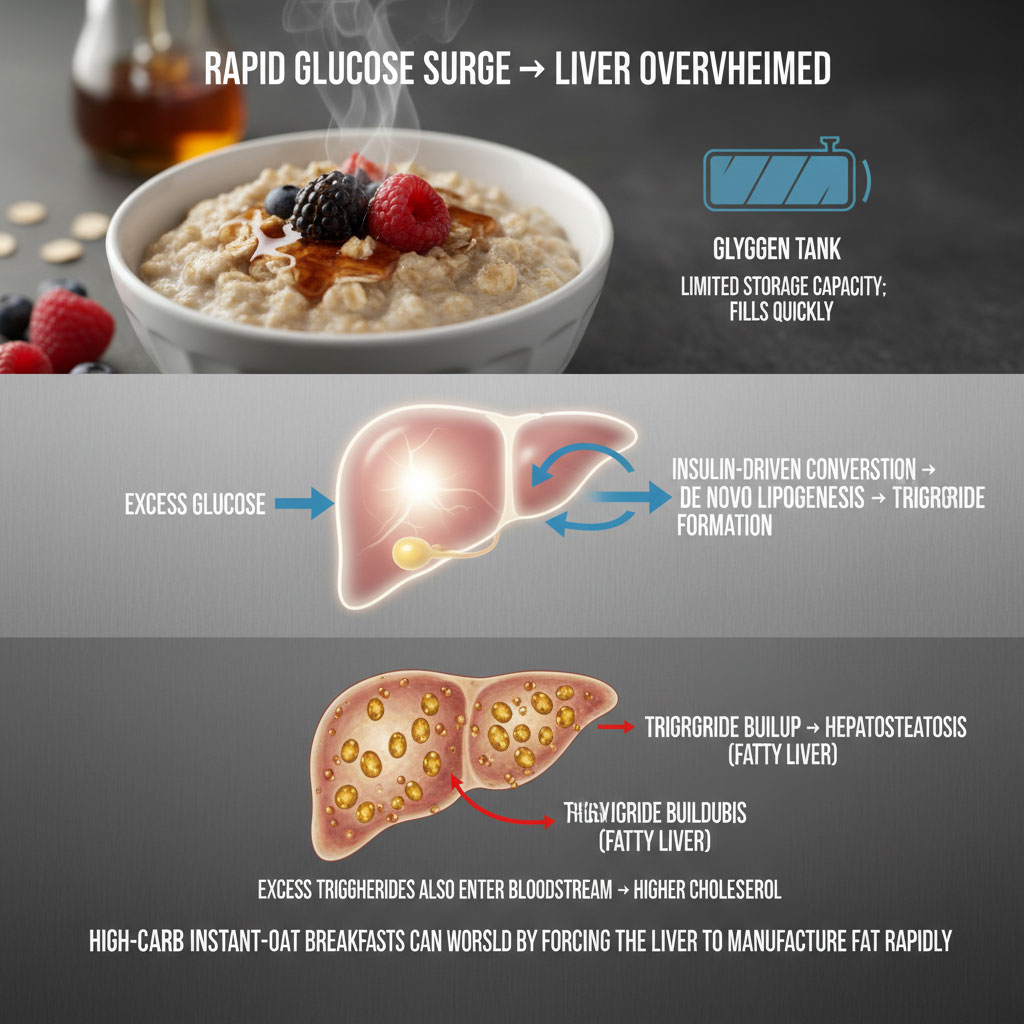
Once that fuel tank is full, which happens quickly in sedentary individuals, the liver has to do something with the excess glucose from the instant oatmeal blood sugar spike. It cannot leave it in the blood, as high blood sugar is toxic. Instead, insulin signals the liver to convert that excess sugar directly into triglycerides.
These triglycerides are tiny droplets of fat. While some are sent out into the bloodstream (raising your cholesterol numbers), many remain trapped inside the liver cells. This accumulation of fat droplets is the defining characteristic of hepatosteatosis, or fatty liver. This is why a high-carb, high-sugar breakfast can be just as damaging as alcohol for those with MASLD diet breakfast concerns. You are essentially force-feeding your liver more energy than it can process, forcing it to manufacture fat.
The Dangers of Hidden Sugars

The issue is compounded by what is added to the oats. The American Heart Association recommends strictly limiting added sugars to prevent metabolic disease. Yet, a single packet of maple and brown sugar instant oats often contains over 12 grams of added sugar. That is equivalent to three teaspoons of sugar consumed before you have even finished your morning coffee.
When you combine the high oatmeal glycemic index of the processed oats with the added sucrose, cane sugar, or high fructose corn syrup found in flavored packets, you create a perfect storm for systemic inflammation. The fructose component of sugar is particularly damaging because it bypasses the body’s satiety signals and goes straight to the liver for fat production. This is why generic “heart healthy” labels on sugary instant oat boxes can be dangerously misleading for liver patients.
Instant vs. Steel Cut vs. Rolled Oats: The Definitive Breakdown
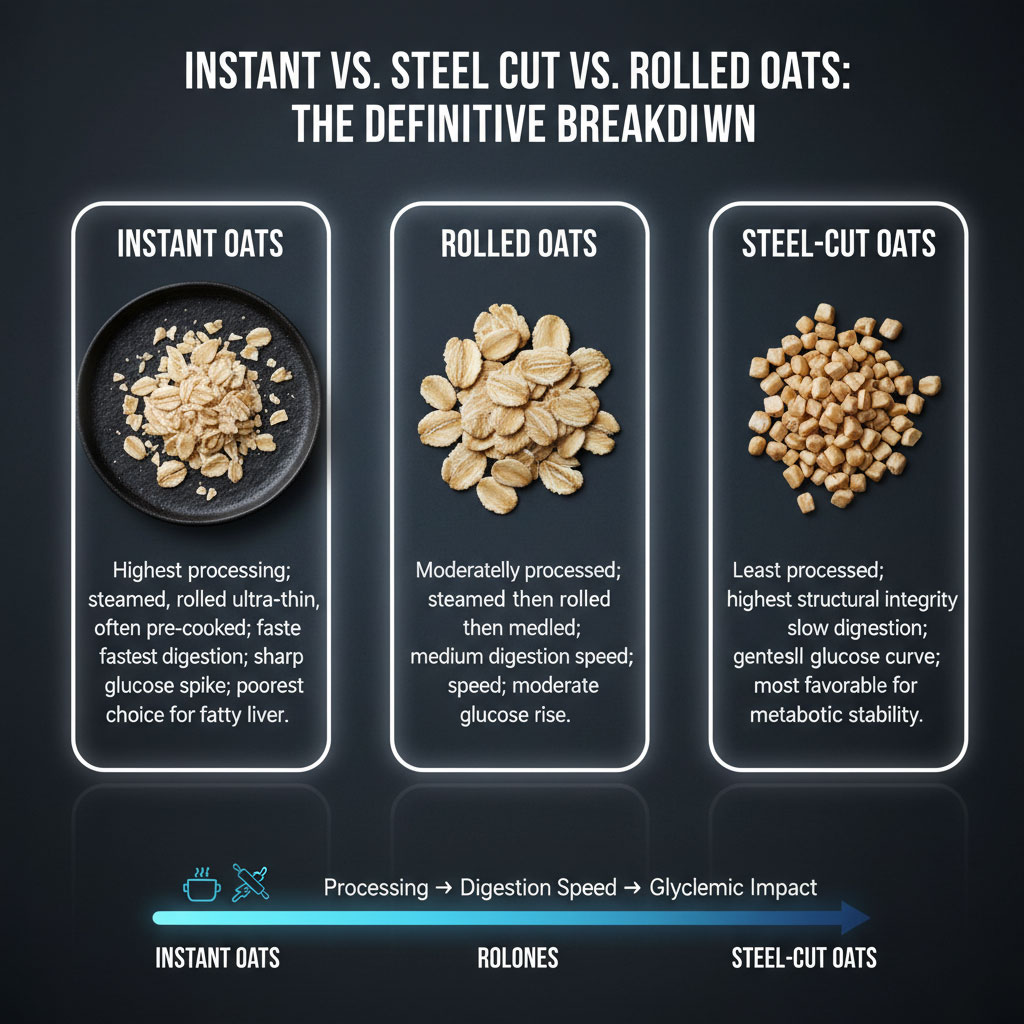
Navigating the cereal aisle can be confusing. To find the best breakfast for fatty liver disease, you need to understand the hierarchy of processing. It is not enough to simply look for the word “oats” on the package; you must understand the mechanical history of the grain inside.
Instant Oatmeal (The Villain)
These are often labeled as “Quick Oats,” “1-Minute Oats,” or simply “Instant.” To make them, the oat groat is steamed for a long period, rolled extremely thin, and then dehydrated. This pre-cooking process gelatinizes the starch, making it soluble the moment water touches it.

Because they require almost no chewing and dissolve instantly in the stomach, they offer almost no satiety. The lack of structural fiber means they pass through the stomach rapidly. You might feel full immediately after eating, but you will likely feel hungry again an hour later as your blood sugar crashes. This crash, known as reactive hypoglycemia, often leads to intense cravings for more carbohydrates, creating a vicious cycle of spiking and crashing that stresses the liver all day long.
Rolled Oats (The Middle Ground)
Also known as “Old Fashioned Oats,” these act as the middle ground between the best and worst options. Like instant oats, they are steamed and rolled to flatten them, which stabilizes the healthy oils inside and extends shelf life. However, they are not rolled as thin as instant oats, and they are usually not pre-cooked to the same degree.

They retain more texture and take longer to digest than the instant variety. However, they can still produce a moderate glucose response depending on how they are cooked. If you boil rolled oats until they are complete mush, you have essentially turned them into instant oats in your own kitchen. If prepared carefully, they can be part of a healthy diet, but they are not the superior choice for reversing disease.
Steel-Cut Oats (The Hero)
Steel cut oats, sometimes called Irish oats, are the gold standard for metabolic health. They are simply whole oat groats that have been chopped into two or three pieces with a sharp steel blade. They are not rolled. They are not steamed. They are not pre-cooked.
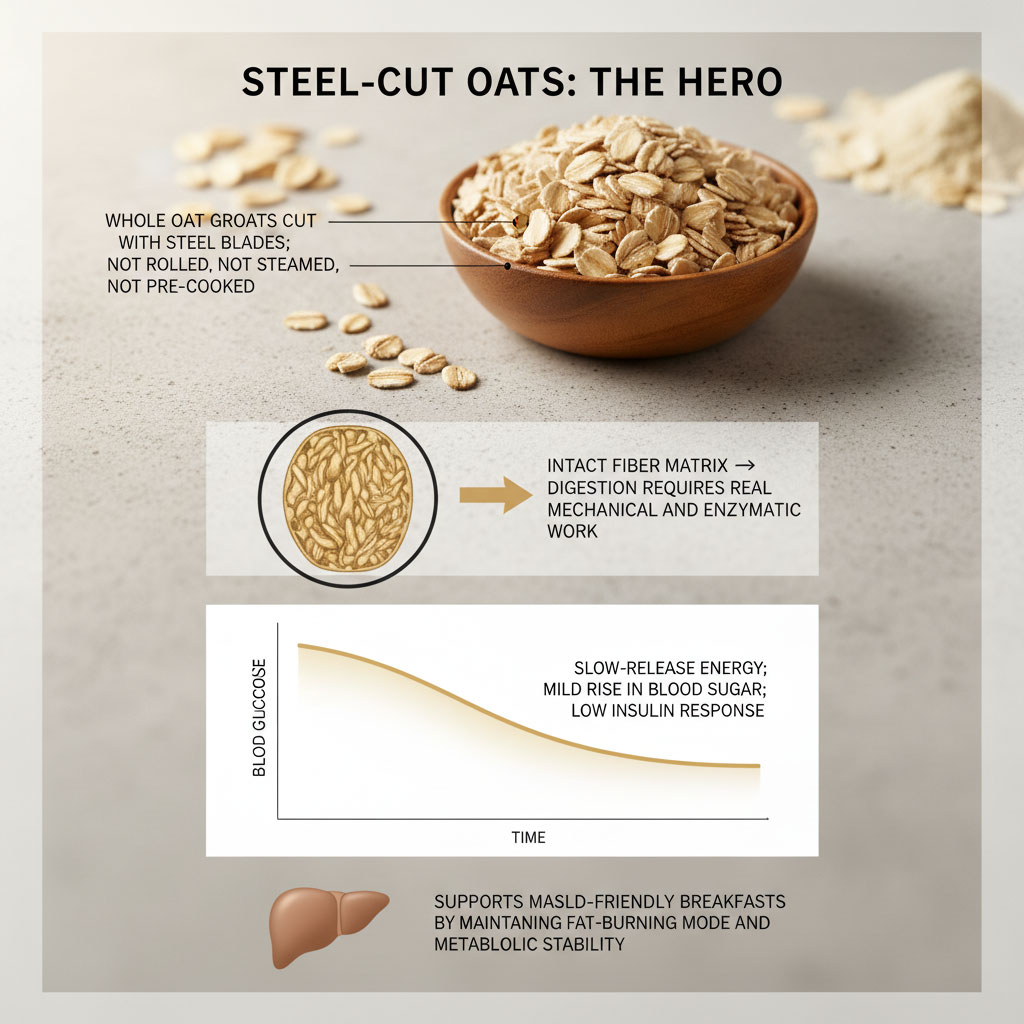
Because the kernel remains largely intact, your body is forced to do the work of digestion. Your stomach acid and enzymes must physically penetrate the dense fiber matrix to access the starch granules inside. This results in a gentle, rolling rise in blood sugar rather than a sharp spike. This slow-release energy profile makes them the superior choice for a MASLD diet breakfast, as they keep insulin levels low and allow the body to stay in fat-burning mode.
Comparison of Nutritional & Metabolic Impact
| Feature | Instant Oatmeal (Quick Oats) | Rolled Oats (Old Fashioned) | Steel-Cut Oats (Irish Oats) |
| Glycemic Index (GI) | High (75–83) | Medium (55–60) | Low (42–55) |
| Digestion Speed | Rapid (Spikes Blood Sugar) | Moderate | Slow (Sustained Energy) |
| Liver Impact | High Insulin Risk (Promotes Fat) | Moderate Risk | Therapeutic (Reduces Fat) |
| Processing Level | Highly Processed (Pre-cooked) | Steam-Rolled | Minimally Processed (Chopped) |
| Best For | Emergency Energy | Baking or Convenience | MASLD / Insulin Resistance |
The Power of Beta-Glucan for Liver Health
Despite the dire warnings about instant varieties, oats have a redemption arc. When consumed in their whole form, oats can be powerful medicine. This is largely due to a specific type of soluble fiber called beta-glucan.
Binding Bile Acids
Beta-glucan has a unique chemical property; it is highly viscous. When it mixes with water in your digestive tract, it forms a thick, sticky gel. This gel moves slowly through your small intestine and captures bile acids.
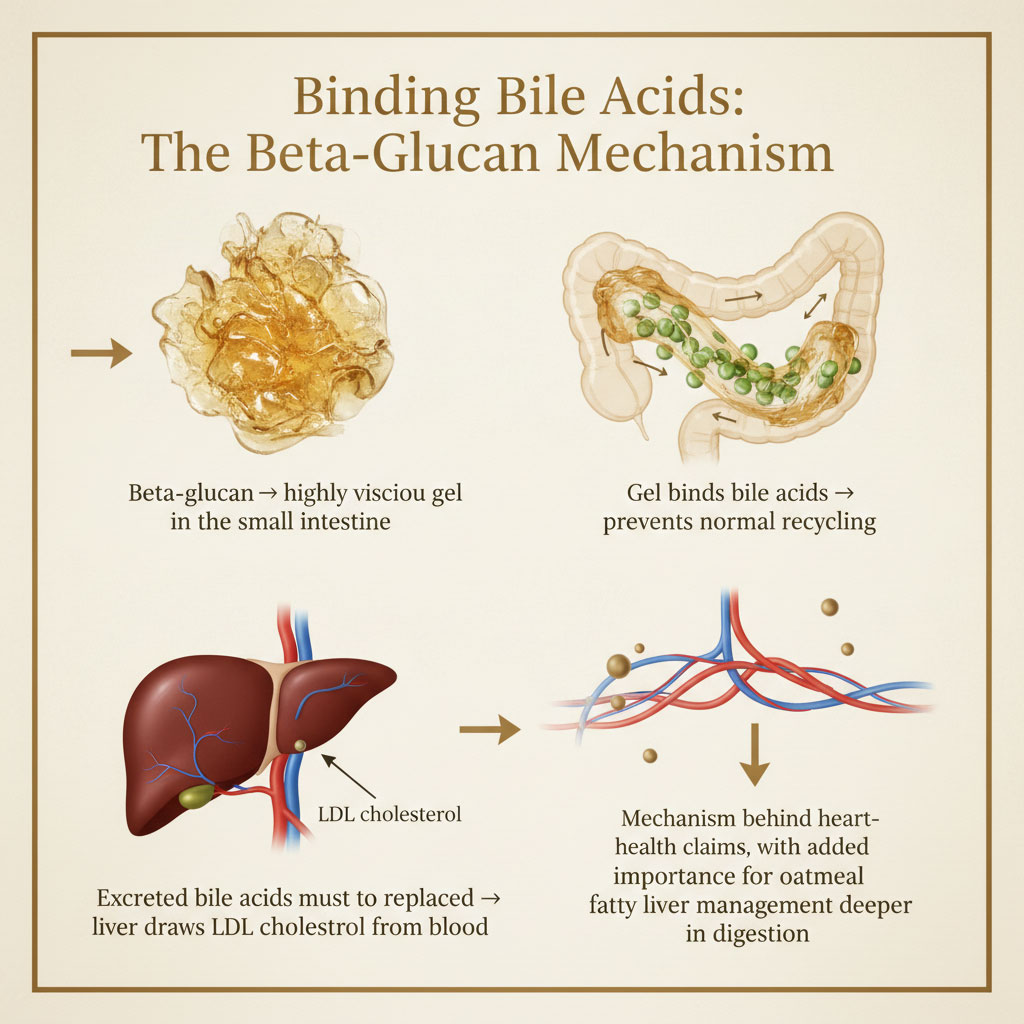
Bile acids are necessary for digestion, and they are made by your liver using cholesterol. Under normal circumstances, your body recycles bile acids, reabsorbing them from the gut to be used again. However, because the sticky beta-glucan gel traps them, they are excreted from the body instead of being recycled.
To replace these lost bile acids, your liver is forced to pull LDL cholesterol from your bloodstream to manufacture new bile. This is the primary mechanism behind the famous heart-health claims associated with oatmeal. However, for oatmeal fatty liver management, there is an even more important benefit occurring further down the digestive tract.
The IfADo Research Connection
Research linked to the Leibniz Institute (IfADo) and other leading metabolic research centers suggests that oat beta-glucans can reduce liver fat accumulation through the modulation of the gut microbiome.
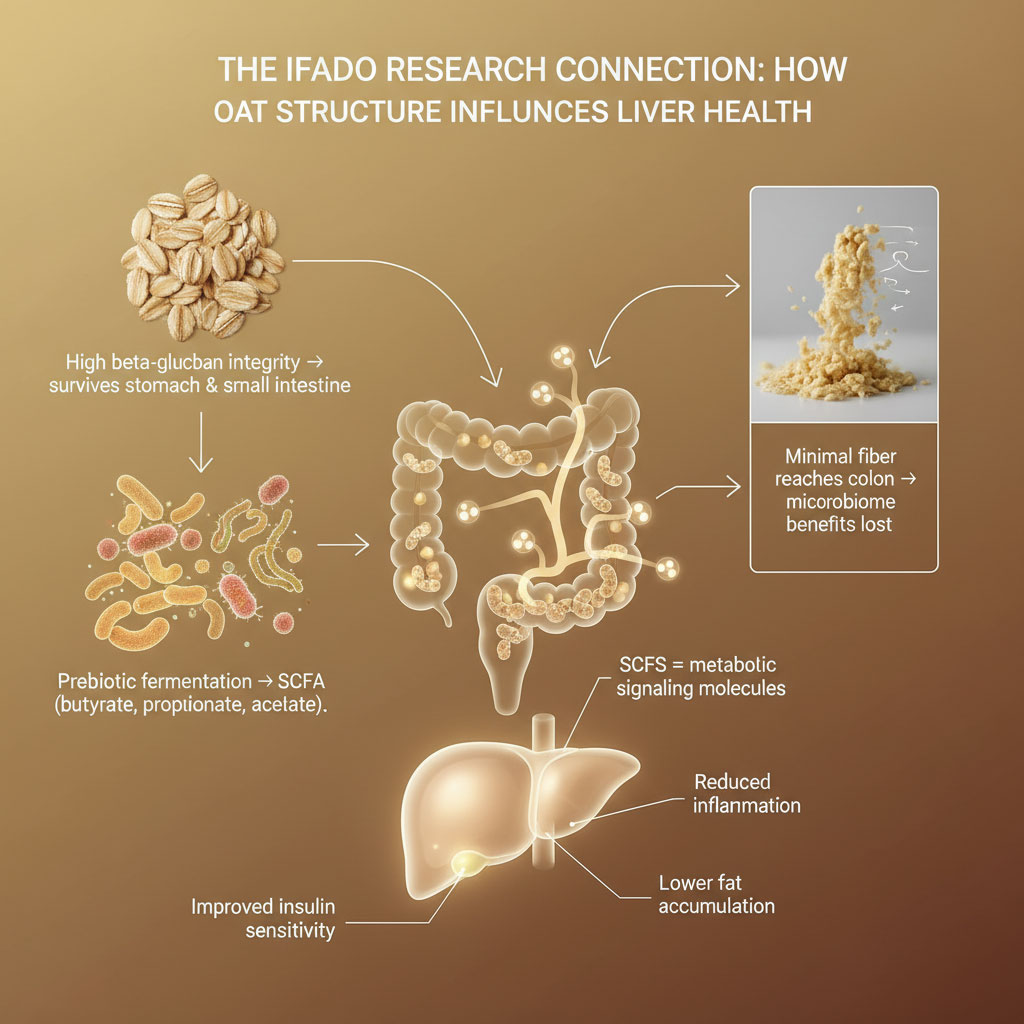
When you eat steel cut oats, much of the fiber survives the journey through the stomach and small intestine. It arrives in the colon largely intact. Here, it acts as a prebiotic feast for your beneficial gut bacteria. These bacteria ferment the fiber and, in return, produce Short-chain fatty acids (SCFAs) such as butyrate, propionate, and acetate.
These SCFAs are signaling molecules. They enter the bloodstream and travel to the liver, where they help reduce inflammation and improve insulin sensitivity. They essentially tell the liver to stop storing fat and start burning it. However, this benefit is lost with instant oats. Because instant oats are absorbed so rapidly in the small intestine, very little fiber makes it to the colon to feed your microbiome. To unlock the beta-glucan liver benefits, the physical structure of the oat matters immensely.
How to Make Oatmeal Blood Sugar Friendly
You do not have to give up oats entirely to save your liver. You simply need to change how you prepare and consume them. By adopting strategies used by the biohacking community and popularized by experts like the Glucose Goddess (Jessie Inchauspé), you can flatten the glucose curve of even a moderate-carb meal.

“Clothing Your Carbs”
One of the most effective strategies to prevent an instant oatmeal blood sugar spike is to never eat carbohydrates “naked.” A naked carb is one that is eaten alone, with no buffer to slow down its digestion.
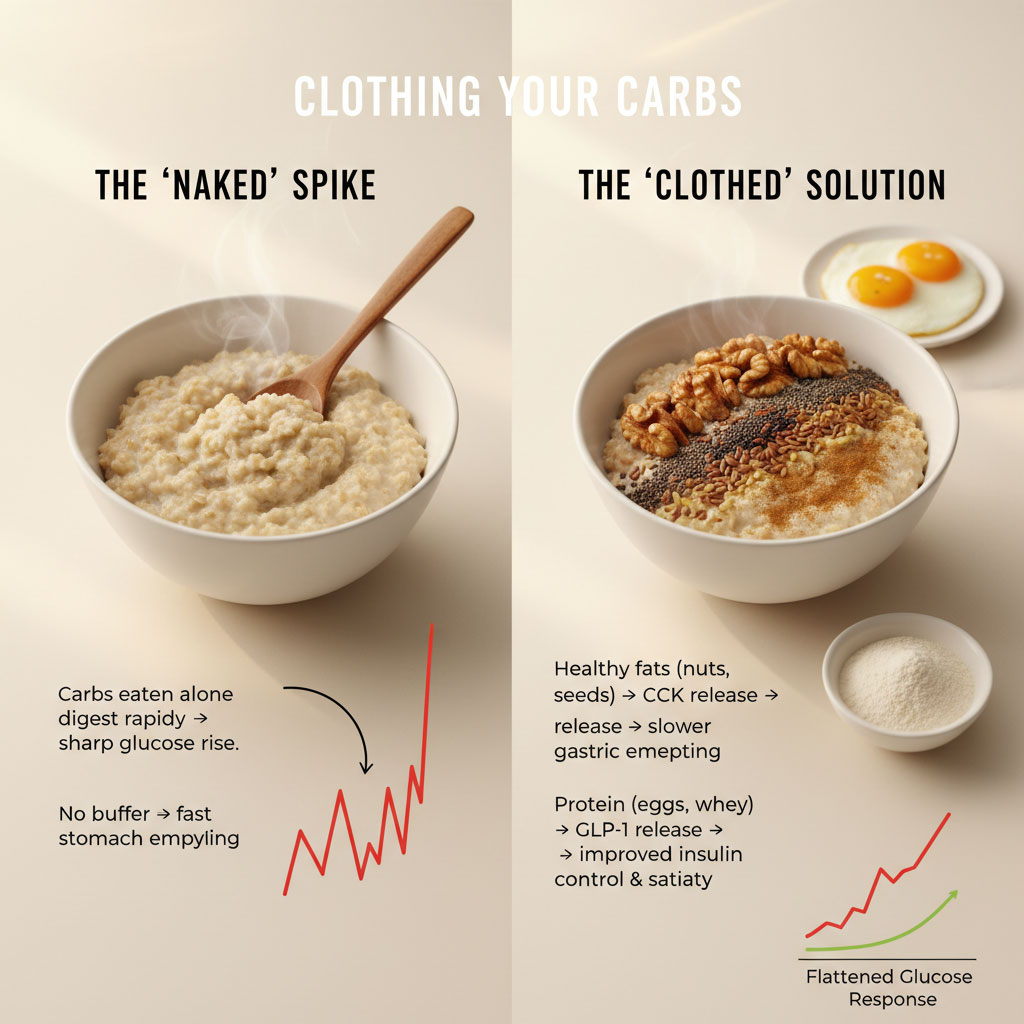
To fix this, you must “clothe” your carbs with fat and protein. This works by triggering hormonal signals in the gut. When fat enters the stomach, it triggers the release of cholecystokinin (CCK), a hormone that slows down gastric emptying.
- Add Healthy Fats: Stirring in walnuts, chia seeds, or flaxseeds adds a physical barrier to the oats and signals the stomach to release food more slowly into the small intestine.
- Add Protein: Mixing in a scoop of high-quality whey protein, hemp hearts, or eating two eggs on the side significantly reduces the postprandial glucose response. Protein stimulates the release of GLP-1, a hormone that regulates insulin and promotes satiety.
The Savory Switch: A New Paradigm
We are culturally conditioned to think breakfast must be sweet. We view oatmeal as a vehicle for brown sugar, maple syrup, and raisins. But sugar and fruit are the last things a fatty liver needs in the morning. Switching to savory oatmeal recipes is a complete game changer for your metabolic health.
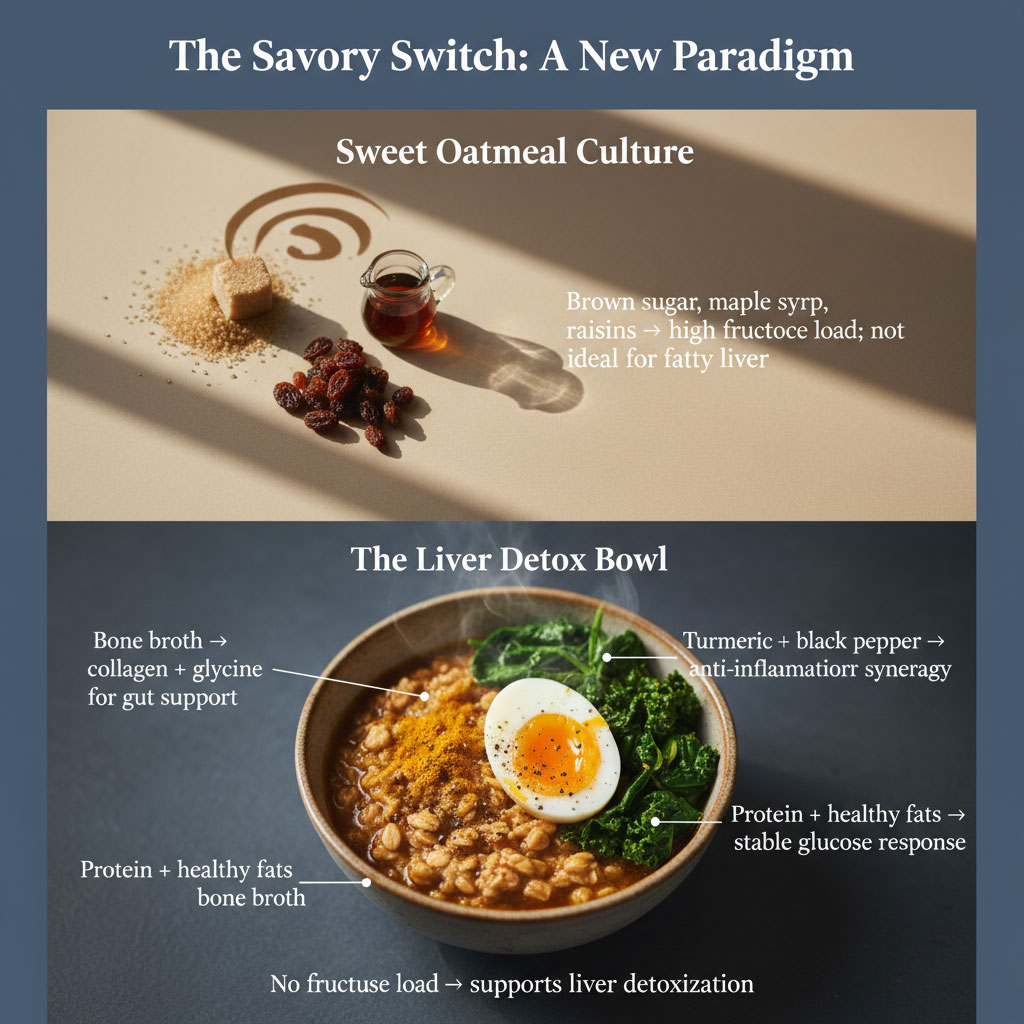
By treating oats like a grain such as rice, quinoa, or risotto, you remove the fructose load entirely. A savory bowl opens the door to anti-inflammatory spices and nutrient-dense vegetables that support liver detoxification.
The Liver Detox Bowl Concept
Imagine a bowl of steel cut oats cooked in bone broth instead of water. The bone broth adds collagen and gut-healing amino acids like glycine. Top the oats with turmeric (a potent anti-inflammatory), cracked black pepper (to activate the turmeric), a soft-boiled egg, and a handful of sautéed spinach or kale. This meal provides fiber, protein, and healthy fats without the sugar spike. It is arguably the best breakfast for fatty liver disease, transforming a potential glucose bomb into a healing, balanced meal.
Preparation Hacks
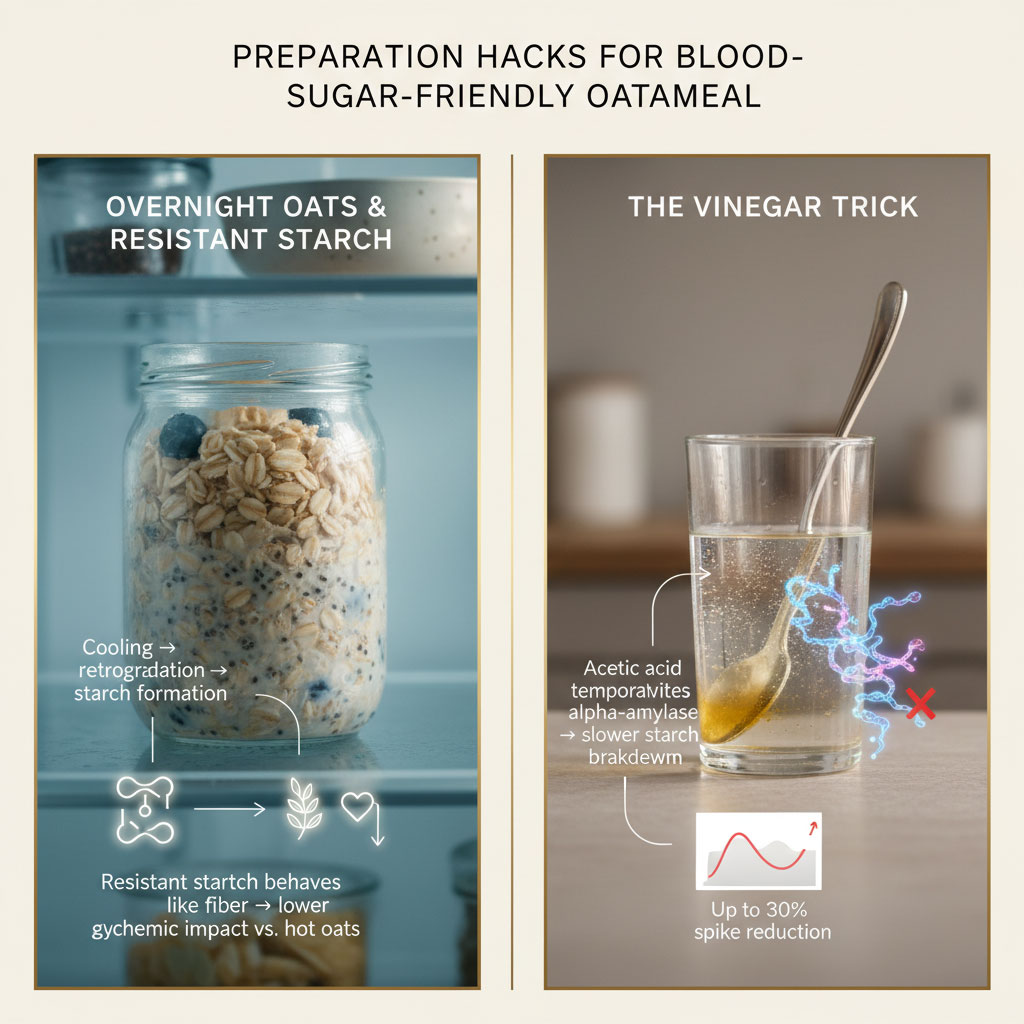
- Overnight Oats & Resistant Starch: Temperature plays a role in how your body handles starch. When you cook oats and then cool them down in the refrigerator, the starch structure changes. It undergoes a process called retrogradation and becomes “resistant starch.” This type of starch resists digestion in the small intestine and acts more like fiber. Consequently, soaking steel cut oats overnight results in a lower glycemic impact than eating them hot off the stove.
- The Vinegar Trick: Taking one tablespoon of apple cider vinegar in a tall glass of water 10 minutes before eating your oats can improve insulin sensitivity. The acetic acid in vinegar temporarily inactivates alpha-amylase, the enzyme in your saliva that breaks down starch into sugar. This means the glucose hits your bloodstream slower, reducing the spike by up to 30%.
The “Spike” Bowl vs. The “Stable” Bowl
| Component | The “Spike” Bowl (Avoid) | The “Stable” Bowl (Eat) |
| Base | Instant Flavored Packet (Maple/Brown Sugar) | Steel-Cut Oats (Plain) |
| Liquid | Skim Milk or Oat Milk (High Sugar) | Water, Bone Broth, or Unsweetened Almond Milk |
| Toppings | Banana, Raisins, Honey, Brown Sugar | Walnuts, Chia Seeds, Berries (Low Sugar), Cinnamon |
| Protein | None | Greek Yogurt, Eggs, or Protein Powder |
| Glucose Impact | Rapid Spike (Like a Candy Bar) | Flat Curve (Steady Energy) |
Buying Guide: Best Brand of Oats for Non-Alcoholic Fatty Liver Disease
When you are standing in the grocery aisle, ignore the front of the box. The “Heart Healthy” stamp is a marketing claim often placed on products loaded with sugar and additives. The truth is found on the back of the package.

Label Reading 101
Turn the box over and scan the ingredient list. If you see “Cane Sugar,” “Corn Syrup Solids,” “Maltodextrin,” or “Natural Flavors” listed in the first three ingredients, put the box back on the shelf. These are fillers that spike blood sugar and dilute the nutritional value of the grain. The best breakfast for fatty liver disease contains exactly one ingredient: Whole Grain Oats.
Recommended Brands
Look for brands that specialize in minimal processing. Bob’s Red Mill Steel Cut Oats and McCann’s Irish Oatmeal are excellent choices widely available in the USA. These brands tend to source high-quality grains with consistent thickness. For those who need a quicker option that isn’t instant, look for “Scottish Oats.” These are stone-ground oats that cook faster than steel-cut because they are ground into smaller pieces, yet they are not pre-cooked or rolled, meaning they retain more nutrition than instant varieties.
Dining Out
If you find yourself at a diner or a coffee shop like Starbucks, ordering oatmeal can be tricky. Commercial oatmeal is almost always the instant variety because it is fast to serve. To minimize the metabolic damage:
- Ask for it plain, with absolutely no brown sugar topping or syrup.
- Throw away the dried fruit packet immediately; dried fruit is essentially concentrated sugar candy.
- Ask for a side of nuts or a pat of butter to add fat, which will slow digestion.
- Do not eat it alone. If possible, order eggs or sausage and eat the protein first. This primes your metabolism and reduces the glucose spike from the oats.
Measuring Progress
How do you know if your switch to steel cut oats vs rolled oats is actually working? You cannot feel your liver repairing itself, so you need data to track your progress.
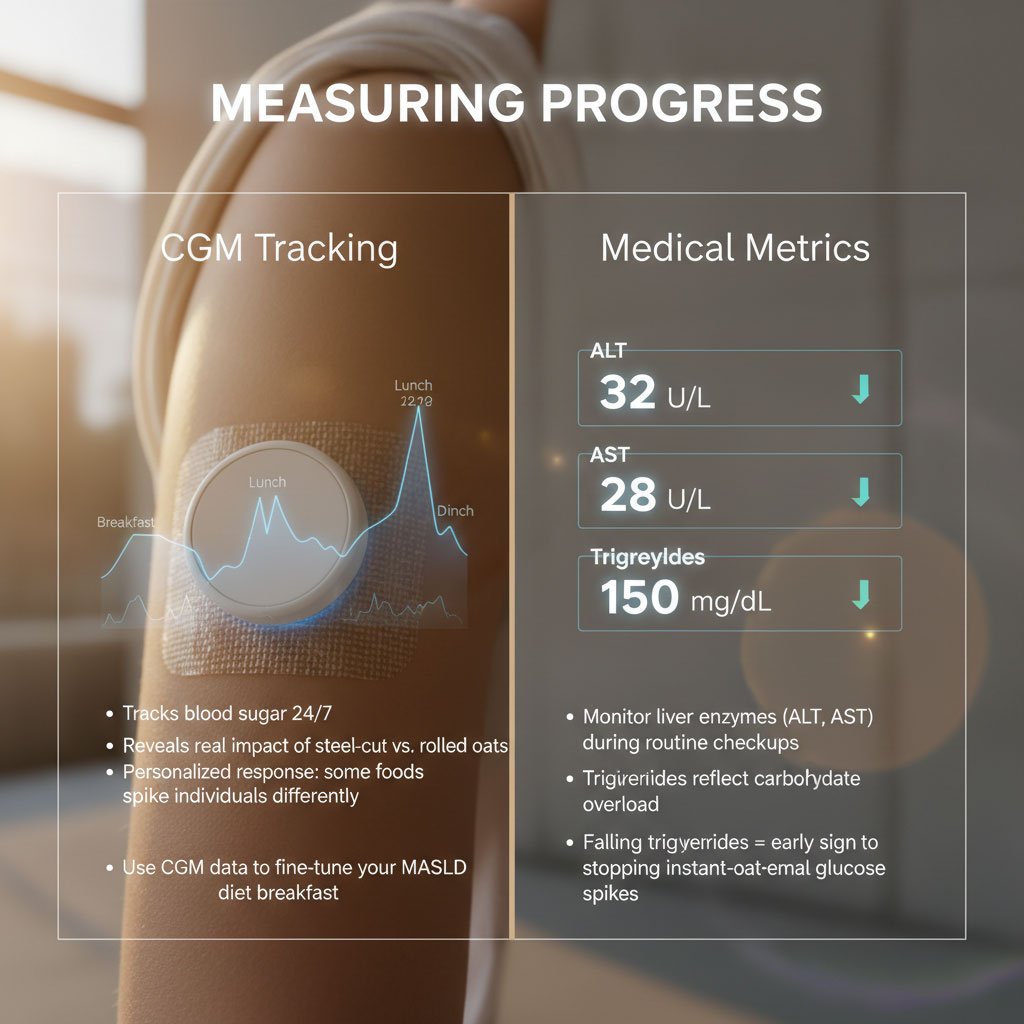
Using a CGM (Continuous Glucose Monitor)
A CGM is a small, wearable device that tracks your blood sugar 24 hours a day. It is the ultimate truth-teller for your diet. While general advice says steel-cut oats are better, individual biology varies. You might find that even rolled oats cause a significant spike for your specific body, while steel-cut oats result in a flat line. This personalized data allows you to fine-tune your MASLD diet breakfast with precision, eliminating guesswork.
Medical Metrics
Beyond blood sugar, keep a close eye on your liver enzymes (ALT and AST) and your triglyceride levels during your routine check-ups. High triglycerides are often a direct result of excess carbohydrate consumption. A reduction in triglycerides is often the first clinical sign that you have successfully stopped the instant oatmeal blood sugar spike cycle and are reversing the drivers of oatmeal fatty liver risks.
Summary & Key Takeaways
The warning is real, but so is the solution. Instant oatmeal blood sugar spike events are a major, often overlooked barrier to healing for anyone with metabolic issues. The heavy processing of instant oats transforms a naturally healthy grain into a rapidly absorbing sugar bomb that fuels oatmeal fatty liver progression.
To reclaim your metabolic health, remember these core rules:
- Switch to Steel-Cut: They are the undisputed king of oats for liver health, providing sustained energy without the crash.
- Clothe Your Carbs: Never eat oats naked. Always add protein and healthy fats to slow digestion and stimulate satiety hormones.
- Go Savory: Ditch the brown sugar habit and embrace savory oatmeal recipes for weight loss to eliminate fructose and add nutrient density.
- Read Labels: Avoid flavored packets at all costs. If it has more than one ingredient, it is likely a processed food.
You do not have to fear oats. You simply need to respect the biology of your liver and choose the form that heals rather than harms. By making the deliberate switch from instant oats vs steel cut, you are taking a powerful, proactive step toward reversing insulin resistance and restoring your metabolic health for the long term.
Frequently Asked Questions (FAQs)
Does instant oatmeal spike blood sugar?
Yes, it does. Because instant oatmeal is steamed and rolled very thin during manufacturing, it digests extremely fast. This causes a rapid surge in blood glucose and insulin levels, which can be harmful for those with insulin resistance or fatty liver issues.
Which oats are best for liver health and MASLD?
Steel-cut oats are the best choice for a MASLD diet breakfast. Their intact kernel structure results in a low glycemic index, preventing insulin spikes while providing adequate beta-glucan fiber to support the gut-liver axis and microbiome health.
Can I eat oatmeal if I have high liver enzymes (ALT/AST)?
Yes, but you should stick to whole groats or steel-cut oats. The soluble fiber can help reduce liver inflammation over time by binding bile acids. However, you must avoid instant varieties with added sugars, as the fructose and rapid glucose release can worsen elevated enzymes and promote hepatosteatosis.
Is overnight oats better for fatty liver than cooked oats?
Generally, yes. Soaking oats allows for the formation of resistant starch. This type of starch resists digestion in the small intestine and ferments in the colon, leading to a lower blood sugar response compared to boiling oats until they are soft and gelatinous.
How do I make oatmeal blood sugar friendly?
Use the “clothing carbs” method. Always add a source of protein (like Greek yogurt, eggs, or protein powder) and healthy fats (like walnuts, flaxseeds, or chia seeds) to your bowl. This combination physically and hormonally slows down the absorption of glucose into the bloodstream.
Are Cheerios or processed oat cereals good for fatty liver?
No. Most processed oat cereals are made from oat flour and often contain added sugar and corn starch. They lack the physical fiber matrix required to blunt the insulin response, making them a poor choice for liver detox breakfast goals.
What is the Glucose Goddess oatmeal hack?
The hack involves three primary steps: eating vegetables or fiber first to create a mesh in the intestine, adding vinegar to water before the meal to improve insulin sensitivity via enzyme inhibition, and never eating sweet oats on an empty stomach without protein.
Can oatmeal help reverse fatty liver?
Oats alone cannot cure the disease, but as part of a low-sugar, high-fiber diet, the beta-glucan liver benefits found in steel-cut oats can help reduce liver fat accumulation and improve cholesterol profiles by modulating gut bacteria.
Why does oatmeal spike my blood sugar even if it’s plain?
Even plain oats are almost 100% carbohydrate. If they are “instant” or “quick” oats, the physical structure is broken down during manufacturing. This allows your body to convert the starch into glucose very quickly, regardless of whether you added sugar or not.
What is a savory oatmeal recipe for weight loss?
A popular recipe involves cooking steel-cut oats in vegetable or bone broth instead of milk. Top the bowl with sautéed kale, a soft-boiled egg, nutritional yeast, and avocado for a high-fiber, high-protein breakfast that keeps insulin low and provides essential micronutrients.
Does soaking oats reduce blood sugar spikes?
Yes. Soaking oats (as in overnight oats) preserves their granular structure better than boiling. It also increases the resistant starch content, which has a minimal impact on blood glucose compared to hot, mushy instant oats that have been gelatinized by heat.
Is instant oatmeal bad for non-alcoholic fatty liver disease (NAFLD)?
It is generally not recommended. The rapid insulin spike caused by instant oatmeal promotes De Novo Lipogenesis, the process where the liver creates new fat from excess sugar. Patients with NAFLD or MASLD should prioritize low-glycemic foods to prevent further fat accumulation.
Medical Disclaimer: The content provided in this article is for informational and educational purposes only and is not intended as medical advice, diagnosis, or treatment. The information regarding oat processing, glycemic index, and metabolic health is based on general research and should not replace a one-on-one relationship with a qualified health care professional. Always seek the advice of your physician or other qualified health provider with any questions you may have regarding a medical condition or dietary change. Never disregard professional medical advice or delay in seeking it because of something you have read on this website.





